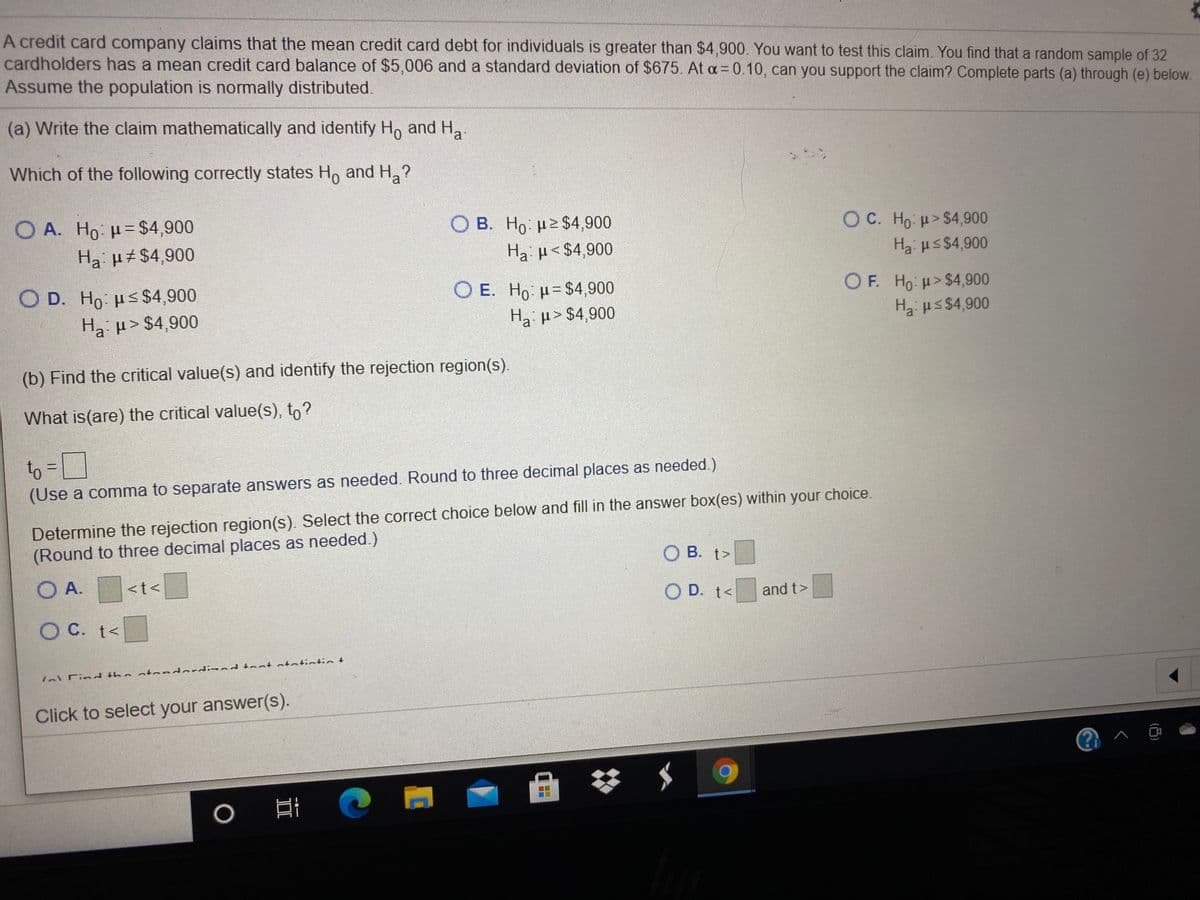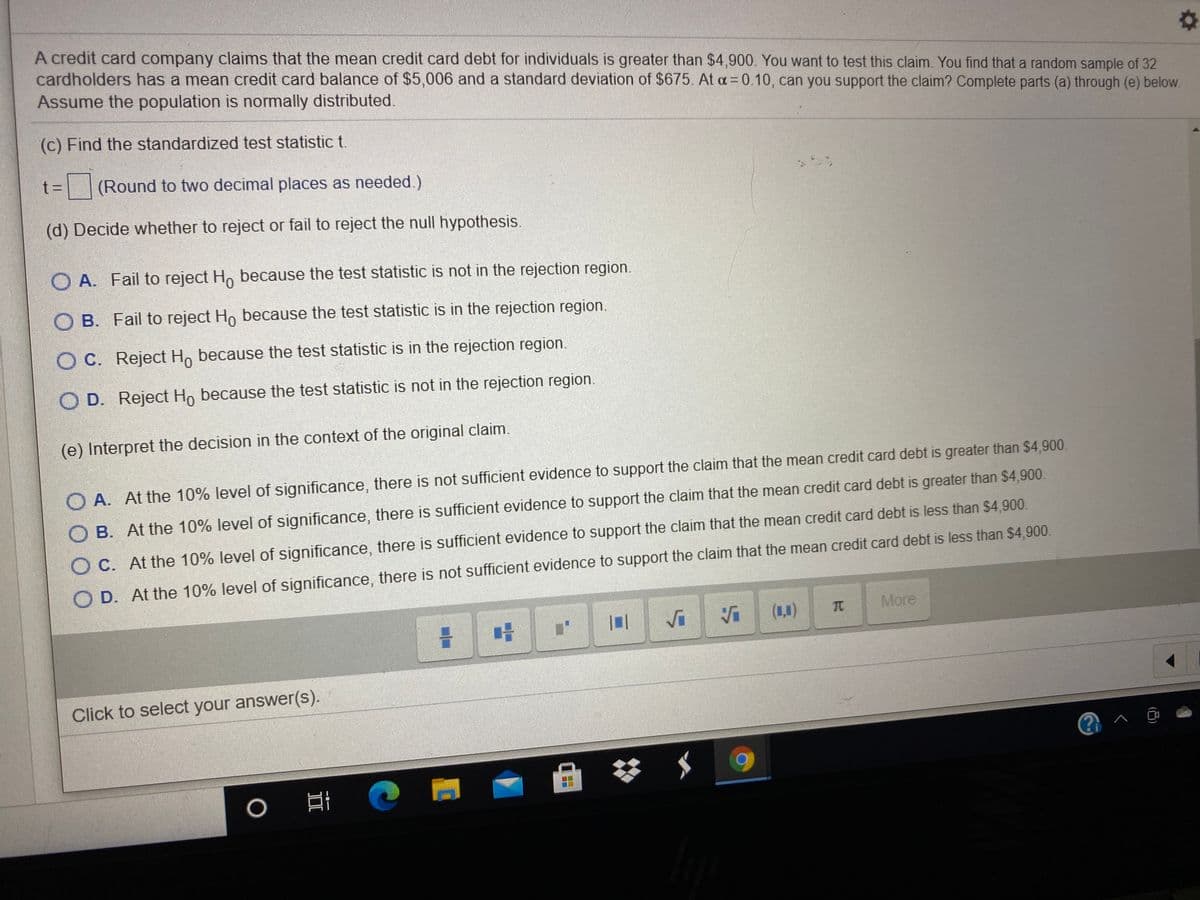A credit card company claims that the mean credit card debt for individuals is greater than $4,900. You want to test this claim. You find that a random sample of 32 cardholders has a mean credit card balance of $5,006 and a standard deviation of $675. At a = 0.10, can you support the claim? Complete parts (a) through (e) below. Assume the population is normally distributed. (a) Write the claim mathematically and identify Ho and H. Which of the following correctly states H, and Ha? O A. Ho H=$4,900 Ha ut$4,900 O B. Ho: µ2 $4,900 OC. Ho u>$4,900 Ha: u< $4,900 Ha uS $4,900 O D. Ho Hs$4,900 O E. Ho H= $4,900 Ha u> $4,900 O F. Ho u> $4,900 Ha us $4,900 Ha: u> $4,900 (b) Find the critical value(s) and identify the rejection region(s). What is(are) the critical value(s), to? to (Use a comma to separate answers as needed. Round to three decimal places as needed.) Determine the rejection region(s). Select the correct choice below and fill in the answer box(es) within your choice. (Round to three decimal places as needed.) О В. 1> O A. O C. t<
A credit card company claims that the mean credit card debt for individuals is greater than $4,900. You want to test this claim. You find that a random sample of 32 cardholders has a mean credit card balance of $5,006 and a standard deviation of $675. At a = 0.10, can you support the claim? Complete parts (a) through (e) below. Assume the population is normally distributed. (a) Write the claim mathematically and identify Ho and H. Which of the following correctly states H, and Ha? O A. Ho H=$4,900 Ha ut$4,900 O B. Ho: µ2 $4,900 OC. Ho u>$4,900 Ha: u< $4,900 Ha uS $4,900 O D. Ho Hs$4,900 O E. Ho H= $4,900 Ha u> $4,900 O F. Ho u> $4,900 Ha us $4,900 Ha: u> $4,900 (b) Find the critical value(s) and identify the rejection region(s). What is(are) the critical value(s), to? to (Use a comma to separate answers as needed. Round to three decimal places as needed.) Determine the rejection region(s). Select the correct choice below and fill in the answer box(es) within your choice. (Round to three decimal places as needed.) О В. 1> O A. O C. t<
MATLAB: An Introduction with Applications
6th Edition
ISBN:9781119256830
Author:Amos Gilat
Publisher:Amos Gilat
Chapter1: Starting With Matlab
Section: Chapter Questions
Problem 1P
Related questions
Topic Video
Question

Transcribed Image Text:A credit card company claims that the mean credit card debt for individuals is greater than $4,900. You want to test this claim. You find that a random sample of 32
cardholders has a mean credit card balance of $5,006 and a standard deviation of $675. At a = 0.10, can you support the claim? Complete parts (a) through (e) below.
Assume the population is normally distributed.
(a) Write the claim mathematically and identify H, and Ha
Which of the following correctly states Ho and H?
O A. Ho H= $4,900
O B. Ho µ2 $4,900
Ha µ< $4,900
Oc.
O C.
Ho $4,900
Ha: µ#$4,900
Ha: uS $4,900
O D. Ho: Hs $4,900
O E. Ho: H= $4,900
H3 µ> $4,900
OF. Ho u>$4,900
Ha: us$4,900
Ha µ> $4,900
a
(b) Find the critical value(s) and identify the rejection region(s).
What is(are) the critical value(s), to?
to=
(Use a comma to separate answers as needed. Round to three decimal places as needed.)
Determine the rejection region(s). Select the correct choice below and fill in the answer box(es) within your choice.
(Round to three decimal places as needed.)
O B. t>
O A.
<t<
O D. t<
and t>
O C. t<
Ie inL the otandard ad taat atatintin t
Click to select your answer(s).

Transcribed Image Text:A credit card company claims that the mean credit card debt for individuals is greater than $4,900. You want to test this claim. You find that a random sample of 32
cardholders has a mean credit card balance of $5,006 and a standard deviation of $675. At a = 0.10, can you support the claim? Complete parts (a) through (e) below.
Assume the population is normally distributed.
(c) Find the standardized test statistict.
t%3D
(Round to two decimal places as needed.)
(d) Decide whether to reject or fail to reject the null hypothesis.
O A. Fail to reject H, because the test statistic is not in the rejection region.
O B. Fail to reject Ho because the test statistic is in the rejection region.
O C. Reject H, because the test statistic is in the rejection region.
O D. Reject Ho because the test statistic is not in the rejection region.
(e) Interpret the decision in the context of the original claim.
O A. At the 10% level of significance, there is not sufficient evidence to support the claim that the mean credit card debt is greater than $4,900.
OB. At the 10% level of significance, there is sufficient evidence to support the claim that the mean credit card debt is greater than $4,900.
O C. At the 10% level of significance, there is sufficient evidence to support the claim that the mean credit card debt is less than $4,900.
O D. At the 10% level of significance, there is not sufficient evidence to support the claim that the mean credit card debt is less than $4,900.
(1,1)
TC
More
Click to select your answer(s).
Expert Solution
This question has been solved!
Explore an expertly crafted, step-by-step solution for a thorough understanding of key concepts.
This is a popular solution!
Trending now
This is a popular solution!
Step by step
Solved in 6 steps with 4 images

Knowledge Booster
Learn more about
Need a deep-dive on the concept behind this application? Look no further. Learn more about this topic, statistics and related others by exploring similar questions and additional content below.Recommended textbooks for you

MATLAB: An Introduction with Applications
Statistics
ISBN:
9781119256830
Author:
Amos Gilat
Publisher:
John Wiley & Sons Inc

Probability and Statistics for Engineering and th…
Statistics
ISBN:
9781305251809
Author:
Jay L. Devore
Publisher:
Cengage Learning

Statistics for The Behavioral Sciences (MindTap C…
Statistics
ISBN:
9781305504912
Author:
Frederick J Gravetter, Larry B. Wallnau
Publisher:
Cengage Learning

MATLAB: An Introduction with Applications
Statistics
ISBN:
9781119256830
Author:
Amos Gilat
Publisher:
John Wiley & Sons Inc

Probability and Statistics for Engineering and th…
Statistics
ISBN:
9781305251809
Author:
Jay L. Devore
Publisher:
Cengage Learning

Statistics for The Behavioral Sciences (MindTap C…
Statistics
ISBN:
9781305504912
Author:
Frederick J Gravetter, Larry B. Wallnau
Publisher:
Cengage Learning

Elementary Statistics: Picturing the World (7th E…
Statistics
ISBN:
9780134683416
Author:
Ron Larson, Betsy Farber
Publisher:
PEARSON

The Basic Practice of Statistics
Statistics
ISBN:
9781319042578
Author:
David S. Moore, William I. Notz, Michael A. Fligner
Publisher:
W. H. Freeman

Introduction to the Practice of Statistics
Statistics
ISBN:
9781319013387
Author:
David S. Moore, George P. McCabe, Bruce A. Craig
Publisher:
W. H. Freeman